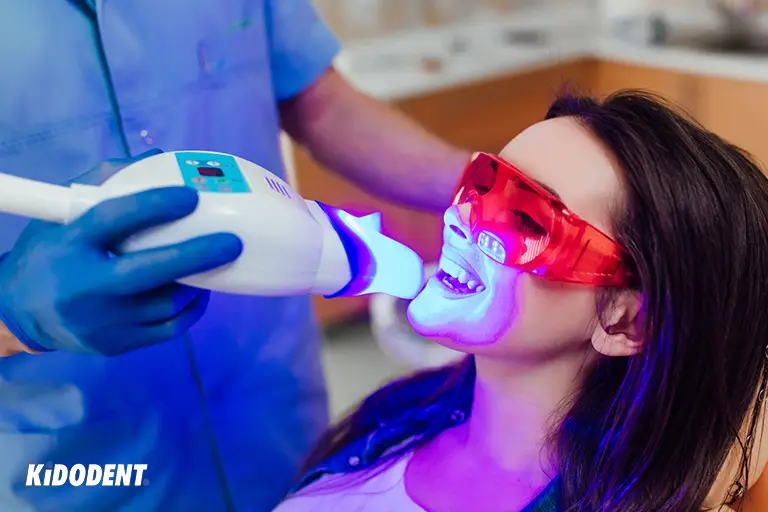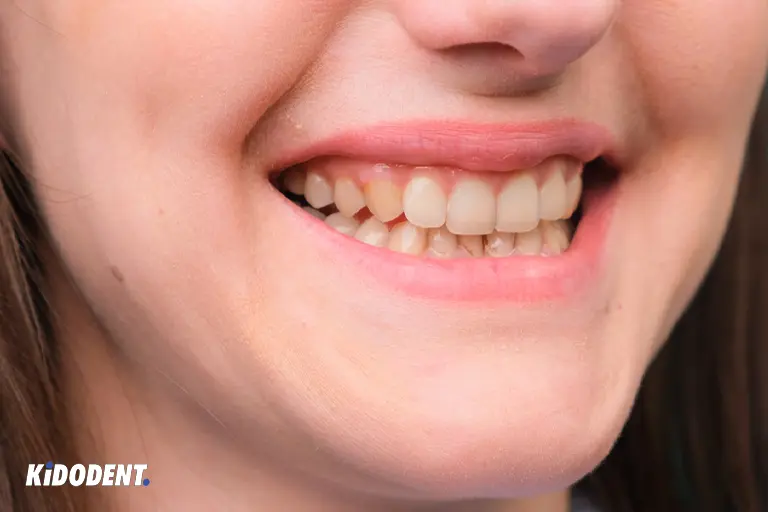If you are looking for fluorosis treatment options, this article will explain the common cosmetic procedures that help you or your child regain the smile. Dental fluorosis, a tooth enamel condition, is caused by long-term fluoride ingestion and happens while teeth develop under the gum (children under 8). It usually shows up as white spots on teeth, but the impacts are permanent and don’t go away. Some cases appear as unsightly discoloration to superficial abnormalities, which need treatment.
Dental fluorosis symptoms
If your child has developed dental fluorosis, once teeth erupt, some changes appear on the tooth enamel. The effects can range from stains or discoloration to surface defects depending on how severe or mild the condition can be. The most common signs are:
- White spots on the enamel (mild forms)
- Yellow to dark brown spots
- Enamel pitting
Side note: Be careful that white spots are a common sign of the early stages of tooth decay caused due to enamel decalcification. So, not every white spot is a fluorosis symptom. Only your dentist can diagnose and detect the exact signs, so go for a dental check.
Dental fluorosis treatment
Keep in mind that fluorosis only affects the appearance of teeth, and it is usually mild in most cases. Fluorosis does not result in cavities or other dental problems. It may show as streaks of faint white flecks on teeth which can go unnoticed and may not even need treatment.
However, you can expect larger white spots, brown staining, and surface defects depending on the severity. Therefore, you will need treatment especially when it occurs to visible front teeth. There are several cosmetic procedures to mask the stains, cover the defects or discoloration, and remove sub or superficial stains like:
Teeth whitening
Teeth whitening or bleaching is an effective way to lighten up stains and therefore treat some mild fluorosis cases. Bleaching is especially recommended as an adjunctive treatment prior to other cosmetic procedures.

Your dentist can perform in-office professional teeth whitening, where more strong whitening agents can help resolve discoloration or even out the whiteness caused by fluorosis on the teeth. Sometimes, dentists may recommend that you continue bleaching at home under their supervision in a series of sessions. There are also low-cost home options for teeth whitening. These include at-home whitening kits or teeth whitening strips, which should only be used when allowed by a dentist.
Resin Infiltration (Icon resin Infiltration)
Used successfully for tooth decay white spots, resin infiltration, also called Icon resin infiltration, is also one of the best methods to treat fluorosis stains. Resin infiltration is a minimally invasive procedure and doesn’t require removing tooth enamel, so no need for injection or numbing. The process is done in a single visit that usually takes less than an hour.
After cleaning and rinsing the teeth, your dentist applies the acid etch (15% hydrochloric acid) to access hypomineralized fluorosis white areas on the enamel. To dry out the lesions and pores on teeth, ethanol solution is applied for 30 seconds. Finally comes the application of resin infiltration in which the resin penetrates deeper into enamel and fills in the pores. The end result will be a pleasing beautiful white smile with teeth that blend in perfectly with the surrounding ones.
Watch the step-by-step fluorosis treatment with Icon resin infiltration:
Composite dental bonding
In case of severe staining and surface defects, a dental bonding procedure is one of the best cosmetic treatments to get. Your dentist will use composite resin, a tooth-colored dental material, to cover up the stains and produce a natural-looking smile.
Dental bonding requires some removal of tooth enamel structure first. Then the composite resin material is applied and light-cured with the blue LED light to set and harden the material. The dentist rebuilds the part of the tooth affected by discoloration or imperfections.
Dental veneers
Another way to cover teeth affected by fluorosis is with dental veneers. Porcelain veneers are thin custom-made shells made of porcelain (a strong ceramic) material that are adhered to the front surface of teeth. They are highly stable and stain-resistant that provide a lasting beautiful smile.
Composite veneers are the other cosmetic procedure to hide any type of imperfections. Different from porcelain, composite veneers are made of composite resin material and don’t require taking an impression. The process is done directly by applying the material followed by shaping and polishing, much like dental bonding except that the entire part of the tooth’s front surface is covered.
Enamel micorabarsion
Enamel microabrasion is a conservative cosmetic method in which a very thin layer of enamel is removed in order to improve teeth appearance affected by surface defects or discoloration. It has long been a common fluorosis treatment. Microabrasion involves the use of acid-abrasive gel or paste which is rubbed on teeth. The dentist abrades away the superficial damage on teeth with the polishing instrument. The treatment can be used in combination with whitening to achieve a perfect bright smile.
Conclusion
The best treatment is always prevention. Keep the amount of fluoride for your child in the right amount. Too little fluoride makes kids’ teeth susceptible to decay; Overexposure to fluoride in young children increases the potential fluoride intake and ingestion.
Check out that children brush their teeth properly and do not swallow fluoride toothpaste. And follow other steps to prevent fluorosis from occurring in the first place. If you notice any discoloration on your child’s teeth or in case you are an adult having the effects on your teeth, visit a dentist and seek treatment.
Frequently asked questions
Once dental fluorosis develops in your child, it cannot be reversed. However, it can be prevented and your dentist can offer treatments to hide or treat it if your child’s teeth are affected.
Minimally invasive cosmetic treatments like resin infiltration, enamel microabrasion, or teeth whitening can fix fluorosis stains. More severe staining or defects can be covered with treatments like composite dental bonding or porcelain veneers.
Dental fluorosis does not develop when teeth are already erupted and obviously doesn’t occur in adults. But the effects can remain in adulthood if not treated.
It is a condition that only happens during the first 8 years of life when the enamel is being formed under the gums. If an adult has fluorosis signs or symptoms, they have gotten it during their childhood and it has possibly gone untreated.
